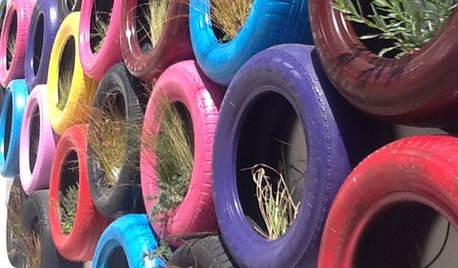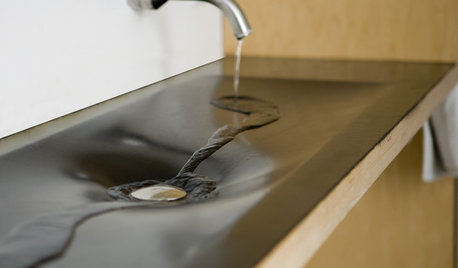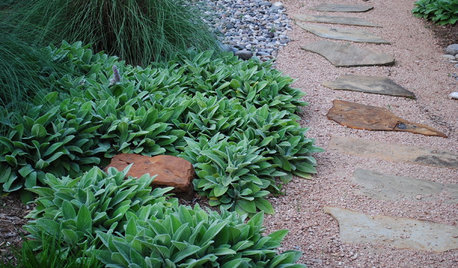brown rubber mulch??
jz500
18 years ago
Featured Answer
Sort by:Oldest
Comments (61)
smlechten
18 years agolast modified: 9 years agoKimmsr
18 years agolast modified: 9 years agoRelated Discussions
Rubber Mulch Advice
Comments (5)I feel your pain - I have a chronic pain condition and I was also incapacitated with Lyme disease last year, and my yard totally got away from me. I learned the truth behind a maxim one of my clients told me: for some jobs, you need a scalpel, for others, you just need a hammer, and Craigslist is full of really really cheap hammers. It looks like you keep up with the day to day so you don't need a skilled pro, you need someone with a truck, a rake, and a desire for cash. As a pro it sort of pains me to advocate for this, but you have a really small, simple task that needs done....See MoreRubber(ized) Mulch?
Comments (7)rubber tires are full of synthetic polymers and heavy metals, that do break down (over decades). The known culprits are arsenic, lead and especially zinc (which in elevated levels will kill plant roots quickly and then inhibit root growth in anything you plant in that soil). Rubber mulch does stink, but only in intense heat. It sounds commendable to reuse rubber mulch on playgrounds BUT since i'd not let my kids play in a tire dump, touch tires and getting their knees, hands, faces dirty with the soot and grime, I sure as hell wouldn't want my kids falling in it on a playground. Regular mulch (that isn't dyed or from treated lumber remnants) is much safer. Even tho it breaks down you know you're not contributing to dumping non-degradable crap all over the soil. That or good old grass and dirt. They ever have the audacity to use rubber tire chips in wetland resorations (to increase soil aeration), which totally seem inappropriate as you are infusing shards of junk into soils that would be impossible to remove outside of digging out topsoils later on....See MoreRubber Tree Dying! Brown spots and shriveling browning leaves
Comments (26)Generally speaking - and I'm no expert here, just have a few houseplants and have been learning a lot from this forum - some plants such as the softer leaves ones will show their displeasure and happiness quite quickly by wilting or perking up quite quickly. But I think some of the thicker leaved firmer plants can look ok for some time even when declining (more water reserves, stronger leaf structure,etc), for example sansevieria (snake plants), so maybe rubber plants are like this too. What I'm trying to say is it may have been going downhill for longer than the two weeks of obvious symptoms. Plus it's possible really high numbers of fungus gnat larvae could have munched on the really fine feeder roots. Although I thought the roots looked good overall. I don't know about the white bugs, you'd need to be sure what they were to know if they damaged it. And the (necessary) repotting was another stress on the plant. Many factors to consider, playing plant detective. It may well be the additive effect of several things. You've had lots of good advice from the experienced people above, on light and soils etc. Personally I would now put it in a bright warm draft-free spot inside, and wait. Don't let the roots dry right out while they're recovering but don't let the soil stay damp either. To achieve this, try using a spray bottle of water on a gentle jet to target where the pruned rootball is, and at the times when you do water more thoroughly leave the pot tilted at 45 degrees (even 30 degrees will help) for 15-20 minutes afterwards and then sit it on towels or paper pushed up against the drain holes for a couple hours. This isn't to remove all the water you just put in, it is to reduce the saturated layer that occurs at the bottom, the "perched water table" (yes, it has a name) Dont fertilise until you see new leaves growing and don't sunburn it by putting it in direct sunshine outside if it's not used to it. Good luck!...See MoreAnyone have some landscaping ideas for my front yard?
Comments (9)I was going to suggest the same as celery. absolutely remove the large shrubs. I'm sure any local nursery can suggest the correct plants for your flower bed. Some other ideas: Just painting your garage door a darker tone (all of that bright white against the dark red brick is too star) and adding some of the carriage hardware to it, makes such a diff I gave you a softer beige, but her dark gray would work too. here's a warm, dark gray w/the carriage hardware (you can buy this on Amazon for less than $40) Looks good w/the dark brick, yes? and don't forget to get some new garage lights that aren't white. any of these would be fine. see these lights? and the hardware on the door? dark red brick, with all of the warmer (don't do a blue gray!) trim and door. since you have some rock in the beds, you could do something like this w/the pots around the front door (which you could also paint. I gave you a peacock blue) just look at the flower beds not the house. they used mexican pebbles and large pots this would also work w/your house color...See MoreViolet_Z6
18 years agolast modified: 9 years agoKimmsr
18 years agolast modified: 9 years agosmlechten
18 years agolast modified: 9 years agobirdtalker
18 years agolast modified: 9 years agoViolet_Z6
18 years agolast modified: 9 years agoKimmsr
18 years agolast modified: 9 years agoViolet_Z6
18 years agolast modified: 9 years agoreginacw
18 years agolast modified: 9 years agobluejean
18 years agolast modified: 9 years agoKimmsr
18 years agolast modified: 9 years agolaurpheus
17 years agolast modified: 9 years agommqchdygg
17 years agolast modified: 9 years agoViolet_Z6
17 years agolast modified: 9 years agosmlechten
17 years agolast modified: 9 years agonomad1
17 years agolast modified: 9 years agocobalt_blue
17 years agolast modified: 9 years agosvick
16 years agolast modified: 9 years agoshellva
16 years agolast modified: 9 years agomarkmpt_hotmail_com
14 years agolast modified: 9 years agocharles_herringconsulting_com
14 years agolast modified: 9 years agojim_w_ny
13 years agolast modified: 9 years agoKimmsr
13 years agolast modified: 9 years agorhizo_1 (North AL) zone 7
13 years agolast modified: 9 years agodms_pinnaclerubbermulch_com
13 years agolast modified: 9 years agosimcan
13 years agolast modified: 9 years agolisascenic Urban Gardener, Oakland CA
13 years agolast modified: 9 years agodarth_weeder
13 years agolast modified: 9 years agosimcan
13 years agolast modified: 9 years agoNadej
12 years agolast modified: 9 years agojolj
12 years agolast modified: 9 years agoNadej
12 years agolast modified: 9 years agomimi2012
11 years agolast modified: 9 years agodmaglothin
3 years agoarmoured
3 years agoUser
3 years agoarmoured
3 years agolast modified: 3 years agoarmoured
3 years agoUser
3 years agolast modified: 3 years agojoe LeGrand
3 years agoarmoured
3 years agoUser
3 years agoJohn D Zn6a PIT Pa
3 years agoarmoured
3 years agoUser
3 years agoUser
3 years agoViolet_Z6
3 years agojoe LeGrand
3 years ago
Related Stories

GARDENING GUIDESHow to Pick a Mulch — and Why Your Soil Wants It
There's more to topdressing than shredded wood. Learn about mulch types, costs and design considerations here
Full Story
GARDENING GUIDESNew Ways to Think About All That Mulch in the Garden
Before you go making a mountain out of a mulch hill, learn the facts about what your plants and soil really want
Full Story
SALVAGECan We Bounce Some Great Recycled-Rubber Ideas Off You?
No need to bemoan that spare tire. Old rubber is getting a guilt-free second life as flooring, pavers, sinks and even furniture
Full Story
GARDENING GUIDESThe Art of Green Mulch
You can design a natural garden that doesn’t rely on covering your soil with wood and bark mulch
Full Story
BATHROOM DESIGNGreen and Clean: Ecofriendly Bathroom Sinks
Sinks crafted from recycled rubber, glass and more make for showstopping bathroom features and are more affordable than ever
Full Story
GARDENING GUIDESGarden Myths to Debunk as You Dig This Fall and Rest Over Winter
Termites hate wood mulch, don’t amend soil for trees, avoid gravel in planters — and more nuggets of garden wisdom
Full Story
GROUND COVERSGround Force: 10 Top Ground Covers for Your Garden
Protect your soil from weeds and drought this summer with a living mulch of ground covers
Full Story
GARDENING GUIDESGot Frost-Damaged Plants? How It Happens, and When and How to Prune
Crispy brown leaves are a sure sign that Jack Frost has been to your neighborhood
Full Story
LIFESimple Pleasures to Savor This Winter
Take time to appreciate the little things, like warm woolen slippers and brown paper packages tied up with string
Full Story
SAVING WATERLush Gardens With Low Water Needs
Drought tolerant doesn’t have mean spindly, brown and thorny
Full Story



toxcrusadr